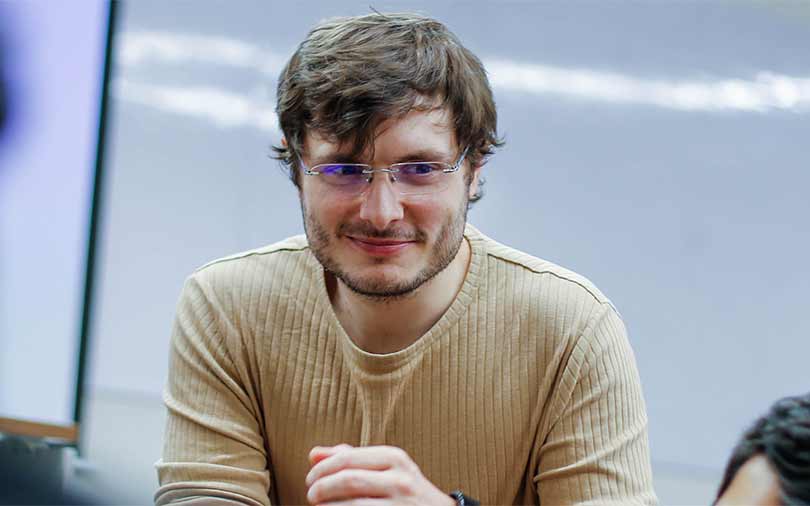
Reboot: After MoonFrog, this founder wants to crack cheat code for social gaming


India was quite an unlikely destination for Welsh entrepreneur Oliver Jones to start off his career. He joined mobile gaming developer Zynga at its Bengaluru office in 2011, right after graduating from Brunel University London where he earned a Masters degree in digital games theory and design. He went on to play a key role in creating one of India’s most popular gaming companies – MoonFrog Labs – and now nearly seven years since shifting base to India, Jones is embarking on another ambitious entrepreneurial expedition.
This time around, he has teamed up with his former Zynga and MoonFrog colleague Abhas Saroha to launch game development startup Bombay Play that aims to make games based on a social-local-multiplayer strategy so that players can better connect through mobile games. The idea is to create games from India that cater to a global audience.
“The apps that have the best engagement are the ones that allow people to connect with other people in a more meaningful way. We are trying to address some fundamental questions here—how do we make games that connect people locally? How do we make it ridiculously easy for people in the same locality to connect and play games together?” Jones explains.

According to him, the tech revolution has not effectively eliminated the barriers that prevent people from effortlessly connecting over a social game. He says the aim of Bombay Play is to simplify that process. Local gaming is the next disruption, he feels, and the winners will be those developers who will enable effortless social connect over mobile games.
“I don’t think the average game developer has realised the power of enabling local play. Everyone says they are doing social, but only a few people are actually doing it. It’s a combination of a social strategy with the right content. Console/PC games figured this problem out a long time ago. Games like Counter-Strike or Dota are played with friends. They all grew because of the social connect. We are yet to see such strong examples of that on mobile,” Jones said. He added it needs a different thought process, one that’s founded on a pure design and creative vision and that’s the difference he’s looking to bring to his second gaming venture.
From Silicon Valley to Bengaluru

Jones worked with Zynga in its pre-initial public offering days, when it was one of the hottest companies in Silicon Valley. It was there that Jones met his future co-founders. “We realised very quickly that there was nothing that we could not do that Zynga was doing. At that time, apps and games were very simple things, not so much large scale, multi-million dollar projects and a small team could make a big impact in this space,” he said.
A group of five executives, including Jones, quit the now NASDAQ-listed company to launch MoonFrog in 2013 with a vision to identify opportunities in mobile gaming and to create products quickly. Jones led the creation of products at MoonFrog.
“The idea was to identify what’s working in the market and make it quicker. It was a smaller team and the margins we could command on these kinds of games were really high, so we decided to try a few of these things and see what happens,” he said

MoonFrog went on to create a number of successful mobile games in the Indian market and raised about $16 million from a slew of marque investors such as Tiger Global and Sequoia Capital. Its flagship hit Teen Patti Gold has been downloaded more than 20 million times and features among the top five highest-grossing games in India on both Android and iOS.
Bombay Play’s global reach
However, Jones had another vision in mind. He quit MoonFrog towards the end of 2016 and worked with another US-listed mobile games producer Glu Mobile at Hyderabad for a little over a year before starting up again.

The idea of Bombay Play as a game development startup took shape when Jones created and sold physical card games on Amazon. Later, he was joined by his former colleague Saroha and the duo created the first game ‘Card Party,’ which is inspired by card games played with family and friends. They launched Bombay Play in March this year.
Evaluating the debut game, internet giant Google selected Bombay Play to its first Indie Games Accelerator, a four-month training programme for gaming startups and developers in Asia. As part of the programme, the team was enlisted in two all-expenses-paid gaming boot camps at Google’s Asia-Pacific office in Singapore. They also received personalised mentorship from Google and gaming industry experts, got an opportunity to showcase their game on Google Play and received $20,000 in Google Cloud Platform and Firebase credits.
The six-player game, currently being beta tested in select regions globally, is scheduled to be officially launched in the first week of November this year. The company plans to launch two more games before the end of this year. “In our beta test, the game is performing very well in Brazil and France and it has a decent number of players in the UK and US. We are also targeting the Japanese and South Korean markets. The other two games in the works are also massively multiplayer games that will allow a lot of people to connect and play together,” Jones said.

He aims to achieve a million app downloads by year-end for Card Party. Bombay Play will also attempt to create mid-core and hard-core gaming experiences on the mobile to leverage the potential of its local-social-multiplayer strategy.
“With the social-local-multiplayer middleware that we have developed, we are confident of releasing a lot of products very quickly. We will also be expanding our team. There is a great pool of creative talent in India, but there doesn’t seem to be many companies that are enabling that talent to the maximum extent,” he added.
